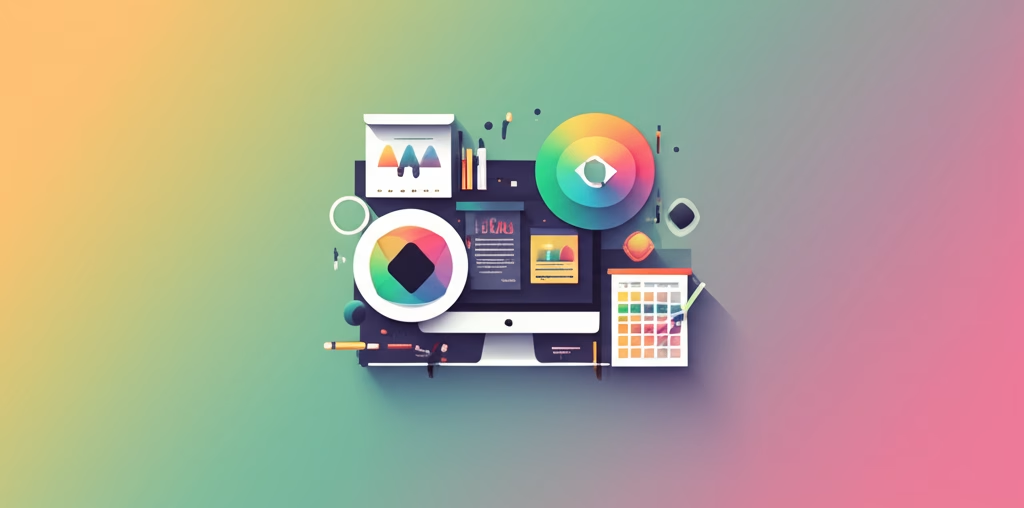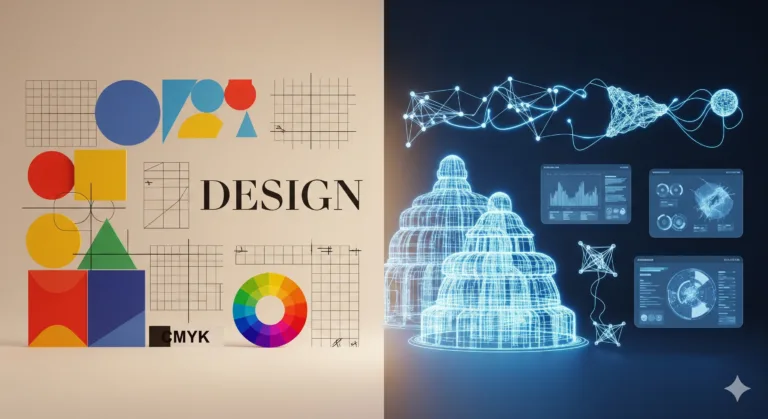The Challenge Every Designer Faces
Starting out in design can feel like walking into a maze. You see amazing visuals everywhere, from websites to social media posts, and wonder, “How do they do that?” It seems like there’s a secret language, a hidden code, that only experienced designers understand. You might feel overwhelmed by the tools, the terminology, and the sheer number of things you need to learn. This initial hurdle can be frustrating and might even make you doubt if you have what it takes to create compelling visuals yourself. But what if I told you that everyone starts from this exact point?
Every skilled designer you admire today began as a beginner, facing the same challenges and uncertainties. The good news is that design isn’t an innate talent reserved for a select few; it’s a skill set that can be learned and developed with the right guidance and practice. This guide is designed to cut through the complexity, offering a clear path for anyone looking to understand the core concepts of visual communication. We’ll tackle the fundamental principles that underpin all great design, making the seemingly complicated world of aesthetics and layout accessible to you. Get ready to transform that feeling of being lost into confidence and capability as we explore the simple truths behind effective visual work.
Table of Contents
The Science Behind Design Demystified for Beginners
At its heart, design isn’t just about making things look pretty. It’s about effective communication. It leverages fundamental principles of human perception and psychology to convey messages, evoke emotions, and guide user interaction. When you look at a well-designed piece, your brain is processing information based on established visual hierarchies, color theories, and spatial relationships. This isn’t magic; it’s the application of how we naturally interpret the world around us. Understanding this ‘science’ helps you move beyond just arranging elements randomly and start designing with intention and purpose, ensuring your message is not only seen but also understood and felt by your audience.
Think about how your eyes move across a page or screen. Good design anticipates this movement, placing the most important information where your gaze is naturally drawn. It uses contrast to highlight key elements and repetition to create a sense of unity and familiarity. Colors aren’t chosen just because they look nice together; they carry cultural and psychological associations that influence mood and perception. Even the empty space, often called ‘negative space’, plays a crucial role in organizing elements and preventing visual clutter. By understanding these underlying principles, you gain the power to influence how your audience perceives and interacts with your creations, making your designs not just visually appealing but also functionally effective.
Fundamental Principles
Balance: This principle refers to the distribution of visual weight in a composition. Elements within a design have visual weight based on their size, color, or texture. Achieving balance means arranging these elements so that no single area feels too heavy or too light, creating a sense of stability and harmony. There are two main types: symmetrical balance, where elements are mirrored on either side of an axis, and asymmetrical balance, where different elements are used on each side but their visual weight is equal. Understanding how to balance elements is crucial for creating layouts that feel stable and pleasing to the eye, guiding the viewer comfortably through the design without creating unease or visual tension.
Contrast: Contrast is about making elements stand out by using differences in their properties. This could be contrasting colors (light vs. dark), sizes (large vs. small), shapes (geometric vs. organic), or textures. High contrast draws attention and creates visual interest, making important information pop. Low contrast can create a softer, more subtle look but might make elements harder to read or distinguish. Using contrast effectively is essential for establishing hierarchy within your design, helping the viewer quickly identify the most important parts of your message and navigate the information easily. It’s a powerful tool for emphasis and organization.
Alignment: Alignment is the principle of arranging elements so their edges or centers line up along an imaginary axis. This creates a clean, organized look and helps to establish visual connections between different parts of the design. Misaligned elements can make a design look messy, unprofessional, and disjointed. Proper alignment provides structure and improves readability, making the information easier to scan and digest. Whether you’re aligning text, images, or shapes, paying attention to alignment brings order and a sense of polish to your work, guiding the viewer’s eye smoothly through the composition.
Repetition: Repetition involves using the same visual elements throughout a design or a series of designs to create consistency and reinforce a message. This could be repeating colors, fonts, shapes, or layout patterns. Repetition helps to unify a design, making different parts feel connected and cohesive. It also helps to establish a brand identity, making your work instantly recognizable. By repeating key elements, you create a sense of rhythm and predictability, which makes the design feel more professional and trustworthy. Consistent use of visual elements builds familiarity and strengthens the overall impact of your communication.
Proximity: Proximity is the principle of grouping related items together. When elements are placed close to each other, they are perceived as being connected or belonging to the same group. This helps to organize information and reduce clutter, making the design easier to understand. Conversely, placing unrelated items far apart helps to distinguish them. Using proximity effectively creates clear relationships between different pieces of content, helping the viewer process information in logical chunks. It’s about using space intentionally to create visual connections and improve the overall clarity and organization of your layout.
Practical Strategies for Design Demystified for Beginners
Knowing the principles is one thing, applying them is another. Here are some practical strategies to help you put these design concepts into action in your own projects, even if you’re just starting out. These approaches are simple yet powerful and can significantly elevate the quality of your visual work from the very beginning. Don’t feel pressured to master everything at once; start by focusing on one or two strategies and gradually incorporate more as you gain confidence and experience. Consistent practice is key to making these strategies feel natural in your creative process.
- Use a Limited Color Palette: [When to use] When you’re unsure about color combinations – [How to apply] Choose 2-3 main colors and their tints or shades. Use online tools to find harmonious palettes.
- Focus on One or Two Fonts: [When to use] To maintain clarity and avoid visual chaos – [How to apply] Select one font for headings and another (or a different weight of the same font) for body text. Ensure they are legible and complement each other.
- Create a Strong Visual Hierarchy: [When to use] When you need to guide the viewer’s eye through information – [How to apply] Use variations in size, weight, color, and placement to make the most important elements stand out. Think about what the viewer should see first, second, and third.
- Embrace White Space: [When to use] To make your design look clean, modern, and easy to read – [How to apply] Don’t be afraid to leave empty space around elements. This gives your design room to breathe and helps to separate different sections of content, improving readability and visual appeal.
Real Cases: When Design Goes Wrong
Learning from mistakes is a fundamental part of the design journey. Sometimes, seeing examples of what doesn’t work can be just as educational as studying successful designs. These real-world cases highlight common pitfalls that beginners and even experienced designers can fall into. By analyzing these situations, you can develop a keener eye for identifying potential issues in your own work and learn how to avoid them before they undermine your message. Let’s look at a couple of scenarios where neglecting basic design principles led to less-than-ideal outcomes, and what valuable lessons we can extract from them to improve our own practice and create more effective visuals.
Case 1: The Overcrowded Flyer
Problem: A local business wanted to advertise a grand opening and tried to include every single piece of information on a small flyer: address, phone number, website, social media handles, a list of products, special offers, a map, and multiple photos. The designer used several different fonts and bright, clashing colors. The result was a chaotic, unreadable mess that overwhelmed potential customers and failed to convey the most important details, like the date and time of the opening. There was no clear focal point, and the sheer volume of competing elements made it impossible to quickly find key information or feel drawn to the event.
Lesson: This case demonstrates the importance of simplicity and hierarchy. Trying to include too much information in a limited space, especially without a clear visual structure, leads to clutter and confusion. The lack of a dominant element meant the viewer didn’t know where to look first. It’s crucial to prioritize information and use design principles like size, contrast, and proximity to guide the viewer to the most essential details. Less is often more; focus on communicating the core message effectively rather than overwhelming your audience with every possible piece of information. Edit ruthlessly and highlight what truly matters.
Case 2: The Illegible Website Text
Problem: An aspiring blogger chose a beautiful, textured background image for their website. However, they then placed light gray text directly on top of the busy, light-colored areas of the image. The text blended into the background, making it extremely difficult and frustrating for visitors to read the articles. Despite having interesting content, the poor contrast and lack of readability meant visitors quickly left the site, unable to comfortably engage with the information presented. The aesthetic choice completely undermined the functional purpose of the website, which was to share written content with an audience.
Lesson: This highlights the critical role of contrast and readability. While a background image can add visual interest, it should never compromise the legibility of your content. Text needs sufficient contrast against its background to be easily read. This applies to both websites and print materials. Always test your text color against your background to ensure it passes accessibility standards and is comfortable for everyone to read. Prioritize function (readability) over purely aesthetic choices that hinder communication. Simple solutions like adding an overlay behind the text or choosing a less busy background could have easily solved this problem.
Your Action Plan for Design Demystified for Beginners
Now that you have a better grasp of fundamental design principles and common pitfalls, it’s time to start applying what you’ve learned. Design is a skill that improves with practice, so the most important step is to simply begin creating. Don’t wait until you feel like an expert; start experimenting with these concepts in small projects today. This action plan provides a simple roadmap to help you integrate these principles into your creative process and build your confidence gradually. Remember, every project is an opportunity to learn and grow, so embrace the process and have fun with it.
- Today: Choose one simple design principle, like alignment or proximity, and consciously apply it to a small project, such as designing a basic social media graphic or a simple document layout. Pay attention to how this single principle impacts the overall look and feel.
- This Week: Experiment with contrast. Try creating two versions of the same design element (like a heading) using different levels of contrast with the background. Observe which one is more noticeable and easier to read. Explore different color combinations and font pairings.
- This Month: Start paying critical attention to the design around you. Analyze websites, advertisements, and packaging, identifying how designers are using the principles of balance, repetition, and white space. Try to recreate simple layouts you admire to understand their structure.
- Next 3 Months: Take on a slightly larger project, like designing a simple one-page flyer or a multi-section social media profile banner. Consciously try to incorporate multiple principles you’ve learned – balance, contrast, alignment, repetition, and proximity – and see how they work together to create a cohesive and effective design.
Clear Your Doubts about Design Demystified for Beginners
It’s natural to have questions when you’re learning something new. Here are answers to some common doubts that beginners often have about design. Don’t hesitate to seek out more resources and keep asking questions as you continue your learning journey. The design community is often very supportive of newcomers, and there are countless tutorials and guides available online to help you deepen your understanding of specific tools and techniques. Remember, every question you ask is a step towards greater clarity and mastery in your design endeavors.
Q: Do I need expensive software to start learning design?
A: No, absolutely not. There are many free and powerful design tools available, like Canva or GIMP, that are perfect for beginners to practice and create impressive visuals.
Q: How long does it take to become good at design?
A: Mastery takes time and consistent practice, but you can start creating good designs and understanding the core concepts within a few weeks or months of dedicated learning and application.
Q: Is design all about natural talent, or can it be learned?
A: Design is a skill that can definitely be learned and developed through studying principles, practicing techniques, and gaining experience; natural talent can give a head start, but dedication is key.
The Next Step in Your Journey
You’ve taken a significant step by demystifying the fundamentals of design. Understanding these core principles is the foundation upon which all great visual work is built. By applying concepts like balance, contrast, alignment, repetition, and proximity, you can transform your ideas into clear, compelling, and effective visuals. Remember that design is a continuous journey of learning and refinement. Be patient with yourself, keep practicing, and don’t be afraid to experiment. Every project is an opportunity to apply what you know and discover new possibilities.
Keep exploring, keep creating, and watch as your skills and confidence grow. The world of design is vast and exciting, and you now have the essential tools to navigate it successfully. Your ability to communicate visually is a powerful asset, whether for personal projects, a burgeoning freelance career, or enhancing your current role. Embrace the process, learn from challenges, and celebrate your progress along the way. The path to becoming a proficient designer is an incredibly rewarding one, filled with opportunities to express creativity and solve problems visually.
Continue evolving with our guide about Essential Design Tools for Beginners!



